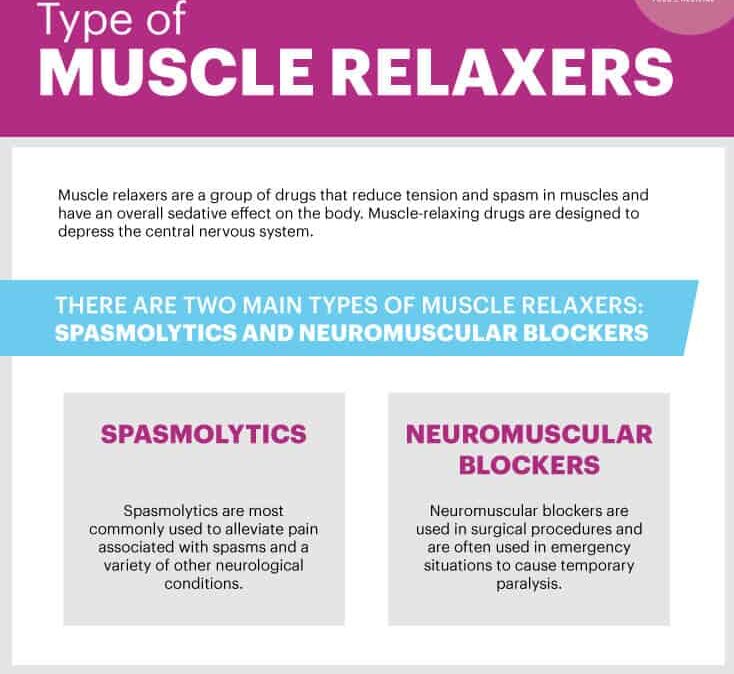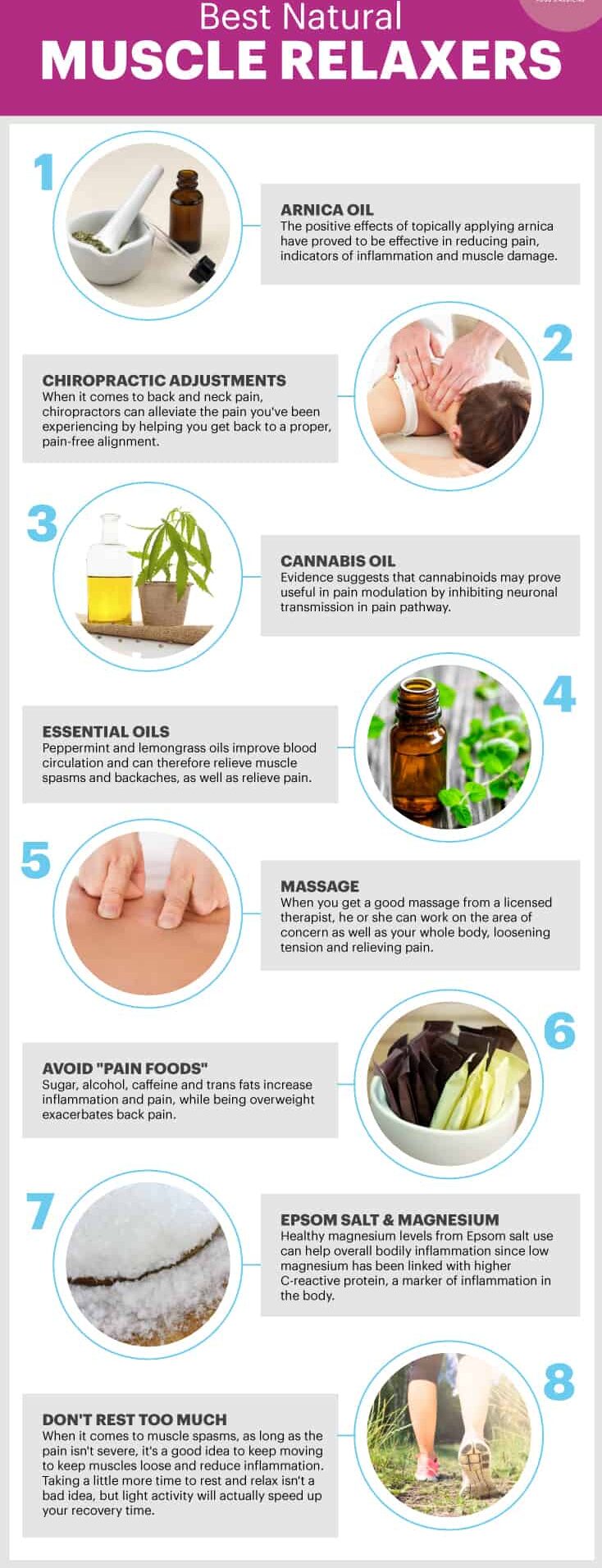8 Best Natural Muscle Soothers
- What Are Muscle Relaxers?
- Best Natural Muscle Relaxers
- Are Muscle Relaxers Addictive?
- Risks and Side Effects

Have you ever considered taking a prescription muscle relaxer or even wondered about it? Just the name might make you think they’re helpful and harmless, but think twice! Synthetic muscle relaxers, unlike a homemade muscle rub, are highly addictive and dangerous when not used as prescribed.
The typical prescription or over-the-counter muscle relaxers, such as non-steroidal anti-inflammatory drugs, don’t actually heal the problem. They simply block the communication between your nervous system and brain, so you don’t feel the pain. However, this effect isn’t localized to the painful muscles alone. The entire body is affected in ways that might not be intended or desirable. You might take a muscle relaxer for a back pain, but it can also impact your arms, legs, and neck just as much. You might fall asleep quickly after taking one, but how do you feel when you wake up? It’s not uncommon to feel like you’ve been hit by a truck, and you’ll likely experience brain fog as well. The pain comes back, and you reach for the bottle of muscle-relaxing pills your doctor prescribed, and the cycle starts over again.
Despite the name, muscle relaxers don’t act directly on the muscular system. Instead, they work on the nervous system. They are often used by people to treat muscle spasms, tightness, and pain associated with backaches, headaches, or fibromyalgia symptoms. But why take a prescription drug when there are so many natural ways to achieve the same goal?
What Are Muscle Relaxers?
A muscle spasm occurs when a muscle is overstretched or torn, causing inflammation. A muscle strain might not seem like a serious injury, but it can cause severe pain for some people, even leading them to the emergency room. Muscle strains or pulled muscles are common in the lower back.
Muscle relaxers are a group of drugs that reduce muscle tension and spasm and have a sedative effect on the body. They are designed to depress the central nervous system. Lower-back problems are one of the most common reasons for using muscle relaxers. However, most acute back pain is a self-limiting condition that will heal on its own within four to six weeks, with or without treatment.
There are two main types of muscle relaxers: spasmolytics (also known as antispastics) and neuromuscular blockers. Spasmolytics are mainly used to relieve pain caused by muscle spasms and spasticity. Muscle spasticity is a neurological condition that causes muscles to remain contracted. Conditions like multiple sclerosis, cerebral palsy, and stroke often require doctors to prescribe muscle relaxers like baclofen, dantrolene, chlorzoxazone, methocarbamol, and tizanidine to treat spasticity. To treat muscle sprains, injuries, or other acute conditions, your doctor might prescribe drugs like metaxalone, carisoprodol, or cyclobenzaprine. Neuromuscular blockers are used in surgical procedures and in emergency situations to cause temporary paralysis. The term “muscle relaxer” or “muscle relaxant” commonly refers to spasmolytics.
Due to the potential side effects, a comprehensive assessment is needed to determine the need for the drug and the duration of use. Muscle relaxers are typically used to treat acute muscle problems and are not recommended for long-term use. Individuals taking these drugs should be under the care of a physician.
The earliest known use of muscle-relaxant drugs dates back to the 16th century when European explorers encountered natives in the Amazon Basin of South America using poison-tipped arrows that caused skeletal muscle paralysis and death. This poison (now known as curare) led to some of the earliest scientific studies in pharmacology. Its active ingredient, tubocurarine, and many synthetic derivatives played a significant role in scientific experiments to understand the function of acetylcholine in neuromuscular transmission. By 1943, neuromuscular-blocking drugs became established as muscle relaxants in the practice of anesthesia and surgery.

Best Natural Muscle Relaxers
1. Arnica Oil
Applied topically in the form of oil, cream, ointment, liniment, or salve, arnica oil is a powerful remedy for various inflammatory and exercise-related injuries. Applying arnica topically has been shown to effectively reduce pain, inflammation indicators, and muscle damage during progressive muscle relaxation. The thymol in arnica is a potent vasodilator of subcutaneous blood capillaries, facilitating the transport of blood and other fluid accumulations and acting as an anti-inflammatory to aid in the normal healing process. Arnica oil also stimulates the flow of white blood cells, which helps clear congested blood and disperse trapped fluid from the muscles, joints, and bruised tissue.
2. Chiropractic Adjustments
Chiropractic adjustments are a drug-free and surgery-free approach to treating pain naturally. In fact, according to research from the College of Chiropractic at Life University in Georgia, chiropractic techniques can be even more effective in reducing pain than muscle relaxers. Chiropractors focus on the proper alignment of your spine. If there are misalignments, they help the spine return to its correct position. When it comes to back and neck pain (including a stiff neck), chiropractors can relieve your pain by helping you achieve a proper, pain-free alignment.
3. Cannabis Oil
Evidence suggests that cannabinoids may be useful in pain modulation by inhibiting neuronal transmission in pain pathways, making cannabis oil a smart choice for a natural muscle relaxer. The oil has the ability to relieve chronic pain and inflammation, which is why it’s sometimes used as a natural treatment for fibromyalgia. If you use cannabis oil, make sure it’s from a reputable company that sells pure and tested oils.
4. Essential Oils
Peppermint oil is a great essential oil to have on hand for various health needs. It is an excellent natural painkiller and muscle relaxant. It’s especially helpful in soothing sore muscles, a painful back, and easing a tension headache. Studies have shown that applying peppermint oil topically has pain-relieving benefits for conditions like fibromyalgia and myofascial pain syndrome. Simply dilute peppermint essential oil in a carrier oil (such as jojoba or coconut) or an unscented lotion and apply it to the affected area. Lemongrass essential oil helps improve blood circulation, which can relieve muscle spasms and backaches. Frankincense and cypress essential oils are also great at reducing inflammation and improving circulation, helping to reduce pain and spasms.

5. Massage
When your body sends a signal to your brain that something hurts, the pain is the body’s way of telling you to stop using that area to allow for the healing process. A prescription muscle relaxer masks the pain and allows you to continue past the point of your body’s comfort, which can prolong the pain and even spread it in the body. When you get a good massage from a licensed therapist, he or she can work on the affected area and your entire body, releasing tension and relieving pain. If you have chronic muscle spasms or pain, it’s ideal to get a massage at least once a month or more. The higher your stress levels, the more likely you are to have muscle tension and pain that requires regular massage. A 2011 clinical, randomized study involving cancer patients in Taiwan researched the effects of massage therapy on muscle pain and relaxation. Researchers found that massage therapy significantly improved bone and muscle pain management in these patients, demonstrating the muscle-relaxing effects of massage.
6. Avoid “Pain Foods”
The following are pain-triggering foods that should be avoided to help relax muscles:
- Sugar: Sugar is pro-inflammatory and can increase pain.
- Alcohol: It also worsens inflammation.
- Caffeine: Caffeine can be dehydrating and may increase inflammation. Limit yourself to no more than one cup of coffee daily, or cut back completely if possible.
- Trans fats: These fats increase inflammation and pain.
- Excess calories: Being overweight can exacerbate back pain.
7. Epsom Salt and Magnesium
Signs of magnesium deficiency include muscle pain, fibromyalgia, and leg cramps. Soaking your whole body or even just your feet in Epsom salt can increase your internal magnesium levels, which are essential for your muscles to function properly and avoid the need for muscle relaxers. Generally, healthy magnesium levels from Epsom salt use can help reduce overall bodily inflammation as low magnesium has been linked to higher C-reactive protein, a marker of inflammation in the body. (6)
8. Don’t Rest Too Much
When it comes to muscle spasms, as long as the pain isn’t severe, it’s a good idea to keep moving to keep muscles loose and reduce inflammation that causes the problem. If needed, slow down your daily activities. Definitely avoid any movements that might have started your pain or seem to aggravate it. Taking a little more time to rest and relax isn’t a bad thing, but light activity will actually speed up your recovery time – so resist spending long hours on the couch watching TV and keep your blood flowing. Of course, if your pain is really unbearable or accompanied by other symptoms, see your doctor right away.
Are Muscle Relaxers Addictive?
In the US and other countries, muscle relaxers are commonly misused and abused. The problem is that these muscle relaxers can be so effective in providing pain relief that people with chronic pain easily become addicted to them. Addiction often occurs when muscle relaxers are used habitually as the main or only method of pain relief. The number of people ending up in the emergency room due to the misuse or abuse of the prescription muscle relaxant carisoprodol has more than doubled in recent years. The US Food and Drug Administration recommends that patients use muscle relaxers only for a limited period (two to three weeks).
When some muscle relaxers, like carisoprodol, are ingested, they are converted by the liver into a chemical with anti-anxiety properties. This means that even when taken alone, patients have a risk of developing a physical and/or psychological dependence on this muscle relaxer. Similar to the use of other pharmaceutical drugs, the body becomes accustomed to a daily intake of a muscle relaxer and then relies on it to function normally. If a typical dose is missed or intake is stopped completely, the person may experience withdrawal symptoms. Muscle relaxers can also cause acute liver toxicity.
Muscle relaxers become even more problematic and risky when combined with alcohol or other drugs. When this happens, the side effects of abuse are even worse.
Risks and Side Effects
Muscle relaxers should not be taken for longer than three weeks. Common side effects of muscle-relaxing drugs include drowsiness, dizziness, dry mouth, urinary retention (inability to completely empty the bladder), fatigue, weakness, and addiction. Some muscle relaxers can also cause acid reflux. In more extreme cases and when muscle relaxers are abused, they can cause heart failure and paralysis. Due to the side effects associated with muscle relaxers, individuals are advised not to drive or operate machinery after using them, and it’s typically recommended to take them before bedtime. Those with a history of drug or alcohol addiction should not use muscle relaxers, and muscle relaxers should never be mixed with alcohol. Carisoprodol (Soma) should especially be avoided as it is associated with a high risk of abuse and addiction potential not seen with other muscle relaxants. Conventional muscle relaxers should not be taken by older adults, pregnant women, or anyone with depression or a history of drug/alcohol addiction.
This is why it’s much better to use the eight natural muscle relaxers mentioned above. Prescription or over-the-counter muscle relaxers have many more harmful side effects and are highly addictive. Instead, heal your muscles and relieve pain with natural, healthy substances to avoid these pitfalls and relax those muscles!




